View in other NatureServe Network Field Guides
NatureServe
Montana
Utah
Wyoming
Idaho
Wisconsin
British Columbia
South Carolina
Yukon
California
New York
Large Marble - Euchloe ausonides
General Description
The following is taken from Ferris and Brown (1981), Scott (1986), Opler and Wright (1999), Glassberg (2001), and Pyle (2002). Large Marble butterflies are medium-sized with a wing span of 3.75-5 mm (1.5-2 inches). From the top (dorsal), their front wings are white with dark green patterning near the tips. The top of the hindwing can be greenish-yellow for females and white with grey patterning for males. Underneath (ventral), their hindwing is distinctive; the white background has green patterning with yellow veins. The yellow veins separate this species from other closely related marble species.
Caterpillars have short, sparse setae (insect hair), and have yellow and green strips that extend the length of their body, and small black spots. Eggs are white ovals with ridges extending longitudinally. Their cocoon (chrysalis) is long and slender, pointed at the ends, tan in color, has ridges along the length and camouflaged to blend into the environment.
Phenology
The following comes from Emmel (1964), Scott and Scott (1978), Scott (1986), Scott and Epstein (1987), Glassberg (2001), Guppy and Shepard (2001), Pyle (2002), and Warren (2005). Large Marble have one generation per year in the northern parts of their range (Alaska; adults observed in May through July) and two generations in the southern portion of their range (California; adults observed in February to April and in May to August). Females lay a single egg on a mustard flower. The developing caterpillars eat the flowers and fruits. Large Marbles overwinter as chrysalids and emerge as adults the following spring or summer (Butterflies and Moths of North America).
Diagnostic Characteristics
Best determined by a combination of creamy-white color, forewing with a black-patterned apex encompassing a circular white spot along costa, narrow black bar in forewing cell with scattered white scales in middle; undersurface of forewing with some yellow-green marbling at apex, hindwing with veins noticeably yellower than complex green marbling.
Species Range
Montana Range
Range Descriptions
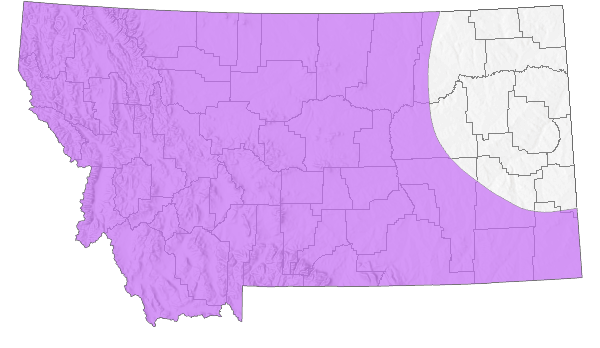
 Native
Native
Range Comments
The Large Marble inhabits western North America. They occurred from Alaska down the western coast to California. The species inhabits states as far east as the Dakotas and New Mexico. The species extends farther east in Canada along the border ranging to the Great Lakes area (Butterflies and Moths of North America). The petition to list the species analyzed data from several sources and showed that the species is observed less frequently in 75% of their range (Burls et al. 2023).
Observations in Montana Natural Heritage Program Database
Number of Observations: 31
(Click on the following maps and charts to see full sized version)
Map Help and Descriptions
Relative Density
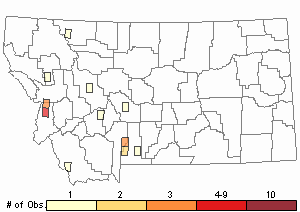
Recency
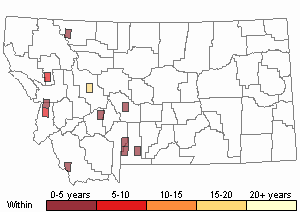
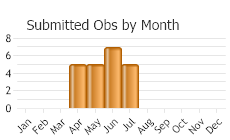

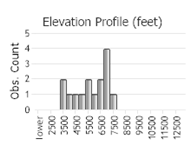 (Observations spanning multiple months or years are excluded from time charts)
(Observations spanning multiple months or years are excluded from time charts)
Migration
Non-migratory; adult straight-line movements average less than 500m but may reach several kilometers (Scott 1975a, 1975c, 1986).
Habitat
Mustards (Brassicaceae spp.) are the host plant for Large Marble butterflies. Adult butterflies are observed in valleys, hillsides, fields and meadows in a variety of habitats. Predictive distribution modeling in the petition based on observations indicated that mountainous areas had better habitat for Large Marbles (Burls et al. 2023). Males follow streams to look for females during breeding (Scott 1975, and Back et al. 2011). Large Marbles were observed in transition areas and mesic montane meadows in Glacier National Park, Montana (Debinski 1993) and open forest, fields, and meadows in the Greater Yellowstone Ecosystem (Debinski and Pritchard 2002).
Food Habits
Larval food plants include native and exotic species such as Arabis (several species), Barbarea, Brassica (several species), Descurainia, Draba, Erysimum, Hirschfeldia, Isatis, Lepidium, Raphanus, Schoencrambe, Sinapis, Sisymbrium (multiple species), and Thelypodium (Opler 1974, Ferris and Brown 1981, Scott 1986, 1992, 2006, Guppy and Shepard 2001, Graves and Shapiro 2003, Pyle 2002, and Warren 2005). Adults feed on flower nectar (including Achillea, Alcea, Amsinckia, Arabis, Arnica, Barbarea, Berberis, Brassica, Brodiaea, Calochortus, Cardamine, Cerastium, Cirsium, Draba, Erodium, Erysimum, Eschscholzia, Heterotheca, Lesquerella, Mertensia, Plantago, Potentilla, Prunus, Ranunculus, Raphanus, Rubus, Senecio, Sisrinchium, Taraxacum, Thlaspi, Townsendia, Trifolium, Wyethia) and mud (Pyle 2002, James and Nunnallee 2011, and Scott 2014).
Reproductive Characteristics
Females lay eggs individually on host plant flower buds and inflorescences, rarely on leaves (Opler 1974, Scott 1986, 1992, 2006, and James and Nunnallee 2011). The number of eggs per ovariole (1/8 of total) is about 70 (Ehrlich and Ehrlich 1978). Eggs hatch in about 4 days, develop from L1 instar to L5 instar and pupate in another 18 days (depending on temperature). Larvae are solitary, feed on all parts of host plant, rest among flower clusters, and build no nest (Scott 1986, and James and Nunnallee 2011). Overwinter (diapause) as pupae, usually on host plant (Opler 1974, Scott 1979, 1986, and James and Nunnallee 2011), adults eclose (emerge from pupae) in spring if from an overwintering cohort. Males patrol throughout the day in open areas and valley bottoms in search of females (Scott 1975b, 1986).
Stewardship Responsibility
References
- Literature Cited AboveLegend:
 View Online Publication
View Online Publication Back, W., M.A. Miller, and P.A. Opler. 2011. Genetic, phenetic, and distributional relationships of Nearctic Euchloe (Pieridae, Pierinae, Anthocharidini). Journal of the Lepidopterists' Society 65(1): 1-14.
Back, W., M.A. Miller, and P.A. Opler. 2011. Genetic, phenetic, and distributional relationships of Nearctic Euchloe (Pieridae, Pierinae, Anthocharidini). Journal of the Lepidopterists' Society 65(1): 1-14. Burls, K., E.R. Spindler, and C. Fallon. 2023. Petition to list the large marble butterfly Euchloe ausonides (Lucas, 1852) as a threatened species and the large marble type subspecies Euchloe ausonides ausonides (Lucas, 1852) under the U.S. Endangered Species Act. The Xerces Society for Invertebrate Conservation. 77 p.
Burls, K., E.R. Spindler, and C. Fallon. 2023. Petition to list the large marble butterfly Euchloe ausonides (Lucas, 1852) as a threatened species and the large marble type subspecies Euchloe ausonides ausonides (Lucas, 1852) under the U.S. Endangered Species Act. The Xerces Society for Invertebrate Conservation. 77 p. Butterflies and Moths of North America. 2023. Collecting and sharing data about Lepidoptera. Accessed 14 November 2023. https://www.butterfliesandmoths.org/
Butterflies and Moths of North America. 2023. Collecting and sharing data about Lepidoptera. Accessed 14 November 2023. https://www.butterfliesandmoths.org/ Debinski, D. 1993. Butterflies of Glacier National Park, Montana. Occasional Papers of the Museum of Natural History, the University of Kansas, Lawrence, Kansas. No. 159: 1-13.
Debinski, D. 1993. Butterflies of Glacier National Park, Montana. Occasional Papers of the Museum of Natural History, the University of Kansas, Lawrence, Kansas. No. 159: 1-13. Debinski, D.M. and J.A. Pritchard. 2002. A field guide to the butterflies of the Greater Yellowstone Ecosystem. Lanham, MD: Roberts Rinehart Publishers. 107 p.
Debinski, D.M. and J.A. Pritchard. 2002. A field guide to the butterflies of the Greater Yellowstone Ecosystem. Lanham, MD: Roberts Rinehart Publishers. 107 p. Ehrlich, A.H. and P.R. Ehrlich. 1978. Reproductive strategies in the butterflies: I. Mating frequency, plugging, and egg number. Journal of the Kansas Entomological Society 51(4): 666-697.
Ehrlich, A.H. and P.R. Ehrlich. 1978. Reproductive strategies in the butterflies: I. Mating frequency, plugging, and egg number. Journal of the Kansas Entomological Society 51(4): 666-697. Emmel, T.C. 1964. The ecology and distribution of butterflies in a montane community near Florissant, Colorado. American Midland Naturalist 72(2): 358-373.
Emmel, T.C. 1964. The ecology and distribution of butterflies in a montane community near Florissant, Colorado. American Midland Naturalist 72(2): 358-373. Ferris, C.D. and F.M. Brown (eds). 1981. Butterflies of the Rocky Mountains. Univ. of Oklahoma Press. Norman. 442 pp.
Ferris, C.D. and F.M. Brown (eds). 1981. Butterflies of the Rocky Mountains. Univ. of Oklahoma Press. Norman. 442 pp. Glassberg, J. 2001. Butterflies through Binoculars: A Field Guide to the Butterflies of Western North America. Oxford University Press.
Glassberg, J. 2001. Butterflies through Binoculars: A Field Guide to the Butterflies of Western North America. Oxford University Press. Graves, S.D. and A.M. Shapiro. 2003.Exotics as host plants of the California butterfly fauna. Biological Conservation 110: 413-433.
Graves, S.D. and A.M. Shapiro. 2003.Exotics as host plants of the California butterfly fauna. Biological Conservation 110: 413-433. Guppy, C.S. and J.H. Shepard. 2001. Butterflies of British Columbia: including western Alberta, southern Yukon, the Alaska Panhandle, Washington, northern Oregon, northern Idaho, northwestern Montana. UBC Press (Vancouver, BC) and Royal British Columbia Museum (Victoria, BC). 414 pp.
Guppy, C.S. and J.H. Shepard. 2001. Butterflies of British Columbia: including western Alberta, southern Yukon, the Alaska Panhandle, Washington, northern Oregon, northern Idaho, northwestern Montana. UBC Press (Vancouver, BC) and Royal British Columbia Museum (Victoria, BC). 414 pp. James, D.G. and D. Nunnallee. 2011. Life histories of Cascadia butterflies. Corvallis, OR: Oregon State University Press. 447 p.
James, D.G. and D. Nunnallee. 2011. Life histories of Cascadia butterflies. Corvallis, OR: Oregon State University Press. 447 p. Opler, P.A. 1968. Studies of Nearctic Euchloe. Part 5. Distribution. Journal of Research on the Lepidoptera 7(2): 65-86.
Opler, P.A. 1968. Studies of Nearctic Euchloe. Part 5. Distribution. Journal of Research on the Lepidoptera 7(2): 65-86. Opler, P.A. 1974. Studies of Nearctic Euchloe. Part 7. Comparative life histories, hosts, and the morphology of immature stages. Journal of Research on the Lepidoptera 13: 1-20.
Opler, P.A. 1974. Studies of Nearctic Euchloe. Part 7. Comparative life histories, hosts, and the morphology of immature stages. Journal of Research on the Lepidoptera 13: 1-20. Opler, P.A. and A.B. Wright. 1999. A field guide to western butterflies. Second edition. Peterson Field Guides. Houghton Mifflin Company, Boston, Massachusetts. 540 pp.
Opler, P.A. and A.B. Wright. 1999. A field guide to western butterflies. Second edition. Peterson Field Guides. Houghton Mifflin Company, Boston, Massachusetts. 540 pp. Pyle, R.M. 2002. The butterflies of Cascadia: a field guide to all the species of Washington, Oregon, and surrounding territories. Seattle Audubon Society, Seattle, Washington. 420 pp.
Pyle, R.M. 2002. The butterflies of Cascadia: a field guide to all the species of Washington, Oregon, and surrounding territories. Seattle Audubon Society, Seattle, Washington. 420 pp. Scott, J.A. 1975a. Movements of Euchloe ausonides (Pieridae). Journal of the Lepidopterists' Society 29(1): 24-31.
Scott, J.A. 1975a. Movements of Euchloe ausonides (Pieridae). Journal of the Lepidopterists' Society 29(1): 24-31. Scott, J.A. 1975b. Mate-locating behavior of western North American butterflies. Journal of Research on the Lepidoptera 14:1-40.
Scott, J.A. 1975b. Mate-locating behavior of western North American butterflies. Journal of Research on the Lepidoptera 14:1-40. Scott, J.A. 1975c. Flight patterns among eleven species of diurnal Lepidoptera. Ecology 56(6): 1367-1377.
Scott, J.A. 1975c. Flight patterns among eleven species of diurnal Lepidoptera. Ecology 56(6): 1367-1377. Scott, J.A. 1979. Hibernal diapause of North American Papilionoidea and Hesperioidea. Journal of Research on the Lepidoptera 18(3): 171-200.
Scott, J.A. 1979. Hibernal diapause of North American Papilionoidea and Hesperioidea. Journal of Research on the Lepidoptera 18(3): 171-200. Scott, J.A. 1986. The butterflies of North America: a natural history and field guide. Stanford University Press, Stanford, California.
Scott, J.A. 1986. The butterflies of North America: a natural history and field guide. Stanford University Press, Stanford, California. Scott, J.A. 1992. Hostplant records for butterflies and skippers (mostly from Colorado) 1959-1992, with new life histories and notes on oviposition, immatures, and ecology. Papilio new series #6. 185 p.
Scott, J.A. 1992. Hostplant records for butterflies and skippers (mostly from Colorado) 1959-1992, with new life histories and notes on oviposition, immatures, and ecology. Papilio new series #6. 185 p. Scott, J.A. 2006. Butterfly hostplant records, 1992-2005, with a treatise on the evolution of Erynnis, and a note on new terminology for mate-locating behavior. Papilio new series #14. 74 p.
Scott, J.A. 2006. Butterfly hostplant records, 1992-2005, with a treatise on the evolution of Erynnis, and a note on new terminology for mate-locating behavior. Papilio new series #14. 74 p. Scott, J.A. 2014. Lepidoptera of North America 13. Flower visitation by Colorado butterflies (40,615 records) with a review of the literature on pollination of Colorado plants and butterfly attraction (Lepidoptera: Hersperioidea and Papilionoidea). Contributions of the C.P. Gillette Museum of Arthopod Diversity. Fort Collins, CO: Colorado State University. 190 p.
Scott, J.A. 2014. Lepidoptera of North America 13. Flower visitation by Colorado butterflies (40,615 records) with a review of the literature on pollination of Colorado plants and butterfly attraction (Lepidoptera: Hersperioidea and Papilionoidea). Contributions of the C.P. Gillette Museum of Arthopod Diversity. Fort Collins, CO: Colorado State University. 190 p. Scott, J.A. and G.R. Scott. 1978. Ecology and distribution of the butterflies of southern central Colorado. Journal of Research on the Lepidoptera 17(2): 73-128.
Scott, J.A. and G.R. Scott. 1978. Ecology and distribution of the butterflies of southern central Colorado. Journal of Research on the Lepidoptera 17(2): 73-128. Scott, J.A. and M.E. Epstein. 1987. Factors affecting phenology in a temperate insect community. American Midland Naturalist 117(1): 103-118.
Scott, J.A. and M.E. Epstein. 1987. Factors affecting phenology in a temperate insect community. American Midland Naturalist 117(1): 103-118. Warren, A.D. 2005. Lepidoptera of North America 6: Butterflies of Oregon, their taxonomy, distribution, and biology. Contributions of the C. P. Gillette Museum of Arthropod Diversity, Colorado State University. Fort Collins, Colorado. 406 pp.
Warren, A.D. 2005. Lepidoptera of North America 6: Butterflies of Oregon, their taxonomy, distribution, and biology. Contributions of the C. P. Gillette Museum of Arthropod Diversity, Colorado State University. Fort Collins, Colorado. 406 pp.
- Additional ReferencesLegend:
 View Online Publication
View Online Publication
Do you know of a citation we're missing? Allen, T.J., J.P. Brock, and J. Glassberg. 2005. Caterpillars in the field and garden: a field guide to the butterfly caterpillars of North America. Oxford University Press.
Allen, T.J., J.P. Brock, and J. Glassberg. 2005. Caterpillars in the field and garden: a field guide to the butterfly caterpillars of North America. Oxford University Press. Brock, J.P. and K. Kaufman. 2003. Kaufman Field Guide to Butterflies of North America. Houghton Mifflin Company, New York, NY 284 pp.
Brock, J.P. and K. Kaufman. 2003. Kaufman Field Guide to Butterflies of North America. Houghton Mifflin Company, New York, NY 284 pp. Brown, F.M. 1957. Colorado Butterflies. Proceedings; Numbers Three through Seven. Denver Museum of Natural History, Denver, Co.
Brown, F.M. 1957. Colorado Butterflies. Proceedings; Numbers Three through Seven. Denver Museum of Natural History, Denver, Co. Caruthers, J.C., and D. Debinski. 2006. Montane meadow butterfly species distributions in the Greater Yellowstone Ecosystem. University of Wyoming National Park Service Research Center Annual Report, 2006. Vol. 30, Art. 14. 85-96.
Caruthers, J.C., and D. Debinski. 2006. Montane meadow butterfly species distributions in the Greater Yellowstone Ecosystem. University of Wyoming National Park Service Research Center Annual Report, 2006. Vol. 30, Art. 14. 85-96. Forister, M.L., C.A. Halsch, C.C. Nice, J.A. Fordyce, T.E. Dilts, J.C. Oliver, K.L. Prudic, A.M. Shapiro, J.K. Wilson, J. Glassberg. 2021. Fewer butterflies seen by community scientists across the warming and drying landscapes of the American West. Science 371:1042-1045.
Forister, M.L., C.A. Halsch, C.C. Nice, J.A. Fordyce, T.E. Dilts, J.C. Oliver, K.L. Prudic, A.M. Shapiro, J.K. Wilson, J. Glassberg. 2021. Fewer butterflies seen by community scientists across the warming and drying landscapes of the American West. Science 371:1042-1045. Forister, M.L., E.M. Grames, C.A. Halsch, K.J. Burls, C.F. Carroll, K.L. Bell, J.P. Jahner, et al. 2023. Assessing risk for butterflies in the context of climate change, demographic uncertainty, and heterogeneous data sources. Ecological Monographs 93(3):e1584. https://doi.org/10.1002/ecm.1584
Forister, M.L., E.M. Grames, C.A. Halsch, K.J. Burls, C.F. Carroll, K.L. Bell, J.P. Jahner, et al. 2023. Assessing risk for butterflies in the context of climate change, demographic uncertainty, and heterogeneous data sources. Ecological Monographs 93(3):e1584. https://doi.org/10.1002/ecm.1584 Kohler, S. 1980. Checklist of Montana Butterflies (Rhopalocera). Journal of the Lepidopterists' Society 34(1): 1-19.
Kohler, S. 1980. Checklist of Montana Butterflies (Rhopalocera). Journal of the Lepidopterists' Society 34(1): 1-19. Layberry, R.A., P.W. Hall, and J.D. LaFontaine. 1998. The Butterflies of Canada. University of Toronto Press. 280 pp. + color plates.
Layberry, R.A., P.W. Hall, and J.D. LaFontaine. 1998. The Butterflies of Canada. University of Toronto Press. 280 pp. + color plates. Sater, S. 2022. The insects of Sevenmile Creek, a pictorial guide to their diversity and ecology. Undergraduate Thesis. Helena, MT: Carroll College. 242 p.
Sater, S. 2022. The insects of Sevenmile Creek, a pictorial guide to their diversity and ecology. Undergraduate Thesis. Helena, MT: Carroll College. 242 p. Stanford, R.E. and P.A. Opler. 1993. Atlas of western USA butterflies: including adjacent parts of Canada and Mexico. Unpubl. Report. Denver and Fort Collins, Colorado 275 pp.
Stanford, R.E. and P.A. Opler. 1993. Atlas of western USA butterflies: including adjacent parts of Canada and Mexico. Unpubl. Report. Denver and Fort Collins, Colorado 275 pp.
- Web Search Engines for Articles on "Large Marble"
- Additional Sources of Information Related to "Insects"





